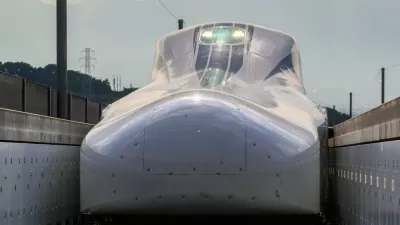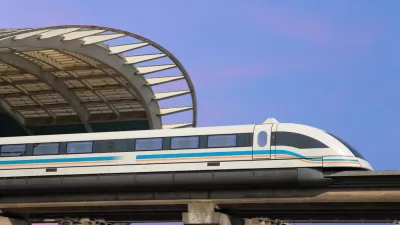A private company, backed by $50 million in funding and some well connected supporters, hopes to kick start a plan to build a magnetic levitation train route from Washington to New York. The technical and financial obstacles are many.
Could Amtrak have some new competition in the chase for the lucrative Northeast Corridor high-speed rail market?
"The Northeast Maglev [TNEM], the 25-employee company founded in 2010, is looking to develop a high-speed magnetic levitation system that would bring passengers from Washington to Baltimore in 15 minutes and to New York in 60 minutes, at speeds of 311 miles an hour," reports Catherine Ho. With an advisory board stacked with well connected figures such as former Pennsylvania governor Ed Rendell and former Senate majority leader Tom Daschle, and $50 million in private funding, TNEM is "seeking financial, community and political support," report Michael Dresser and Kevin Rector in The Baltimore Sun.
Though TNEM is a private company, it is working closely with engineers from Central Japan Railway, and appears to have support from the highest levels of the Japanese government. "Unlike past proposals, the TNEM group says it can count on financing from a Japanese government bank, reflecting Tokyo’s eagerness to launch the new superconducting maglev technology — developed by Japan Central Railroad — in the U.S. Northeast Corridor," write Dresser and Rector. Japanese Prime Minister Shinzo Abe personally presented an offer including "the use of the technology and 'substantial financial support' — with no amount specified — for a Washington-Baltimore line" to President Obama in a February meeting.
FULL STORY: Organizers line up big names to push new high-speed rail line linking D.C. to N.Y.

Maui's Vacation Rental Debate Turns Ugly
Verbal attacks, misinformation campaigns and fistfights plague a high-stakes debate to convert thousands of vacation rentals into long-term housing.

Planetizen Federal Action Tracker
A weekly monitor of how Trump’s orders and actions are impacting planners and planning in America.

In Urban Planning, AI Prompting Could be the New Design Thinking
Creativity has long been key to great urban design. What if we see AI as our new creative partner?

San Francisco Mayor Backtracks on Homelessness Goal
Mayor Dan Lurie ran on a promise to build 1,500 additional shelter beds in the city, complete with supportive services. Now, his office says they are “shifting strategy” to focus on prevention and mental health treatment.

How Trump's HUD Budget Proposal Would Harm Homelessness Response
Experts say the change to the HUD budget would make it more difficult to identify people who are homeless and connect them with services, and to prevent homelessness.

The Vast Potential of the Right-of-Way
One writer argues that the space between two building faces is the most important element of the built environment.
Urban Design for Planners 1: Software Tools
This six-course series explores essential urban design concepts using open source software and equips planners with the tools they need to participate fully in the urban design process.
Planning for Universal Design
Learn the tools for implementing Universal Design in planning regulations.
Gallatin County Department of Planning & Community Development
Heyer Gruel & Associates PA
JM Goldson LLC
Mpact (founded as Rail~Volution)
City of Camden Redevelopment Agency
City of Astoria
Jefferson Parish Government
Camden Redevelopment Agency
City of Claremont




























